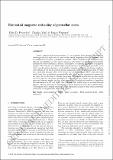Files in this item
The initial magnetic criticality of prestellar cores
Item metadata
| dc.contributor.author | Priestley, Felix D | |
| dc.contributor.author | Yin, Charles | |
| dc.contributor.author | Wurster, James | |
| dc.date.accessioned | 2022-07-29T16:30:04Z | |
| dc.date.available | 2022-07-29T16:30:04Z | |
| dc.date.issued | 2022-10 | |
| dc.identifier | 280657086 | |
| dc.identifier | 5d45cf4a-5d61-4703-a396-d50e84ec0237 | |
| dc.identifier | 000844450800007 | |
| dc.identifier | 85140954239 | |
| dc.identifier.citation | Priestley , F D , Yin , C & Wurster , J 2022 , ' The initial magnetic criticality of prestellar cores ' , Monthly Notices of the Royal Astronomical Society , vol. 515 , no. 4 , stac2107 , pp. 5689–5697 . https://doi.org/10.1093/mnras/stac2107 | en |
| dc.identifier.issn | 0035-8711 | |
| dc.identifier.other | Bibtex: 10.1093/mnras/stac2107 | |
| dc.identifier.other | ORCID: /0000-0003-0688-5332/work/123196711 | |
| dc.identifier.uri | https://hdl.handle.net/10023/25753 | |
| dc.description | FDP is supported by the Science and Technology Facilities Council. | en |
| dc.description.abstract | Direct observational measurements of the magnetic field strength in prestellar cores typically find supercritical mass-to-flux ratios, suggesting that the magnetic field is insufficient to prevent gravitational collapse. These measurements suffer from significant uncertainties; an alternative approach is to utilize the sensitivity of prestellar chemistry to the evolutionary history, and indirectly constrain the degree of magnetic support. We combine non-ideal magnetohydrodynamic simulations of prestellar cores with time-dependent chemistry and radiative transfer modelling, producing synthetic observations of the model cores in several commonly-observed molecular lines. We find that molecules strongly affected by freeze-out, such as CS and HCN, typically have much lower line intensities in magnetically subcritical models compared to supercritical ones, due to the longer collapse timescales. Subcritical models also produce much narrower lines for all species investigated. Accounting for a range of core properties, ages and viewing angles, we find that supercritical models are unable to reproduce the distribution of CS and N2H+ line strengths and widths seen in an observational sample, whereas subcritical models are in good agreement with the available data. This suggests that despite presently having supercritical mass-to-flux ratios, prestellar cores form as magnetically subcritical objects. | |
| dc.format.extent | 714197 | |
| dc.language.iso | eng | |
| dc.relation.ispartof | Monthly Notices of the Royal Astronomical Society | en |
| dc.subject | Astrochemistry | en |
| dc.subject | MHD | en |
| dc.subject | Stars:formation | en |
| dc.subject | ISM: magnetic fields | en |
| dc.subject | ISM: molecules | en |
| dc.subject | QB Astronomy | en |
| dc.subject | QC Physics | en |
| dc.subject | DAS | en |
| dc.subject.lcc | QB | en |
| dc.subject.lcc | QC | en |
| dc.title | The initial magnetic criticality of prestellar cores | en |
| dc.type | Journal article | en |
| dc.contributor.institution | University of St Andrews. School of Physics and Astronomy | en |
| dc.identifier.doi | https://doi.org/10.1093/mnras/stac2107 | |
| dc.description.status | Peer reviewed | en |
This item appears in the following Collection(s)
Items in the St Andrews Research Repository are protected by copyright, with all rights reserved, unless otherwise indicated.

